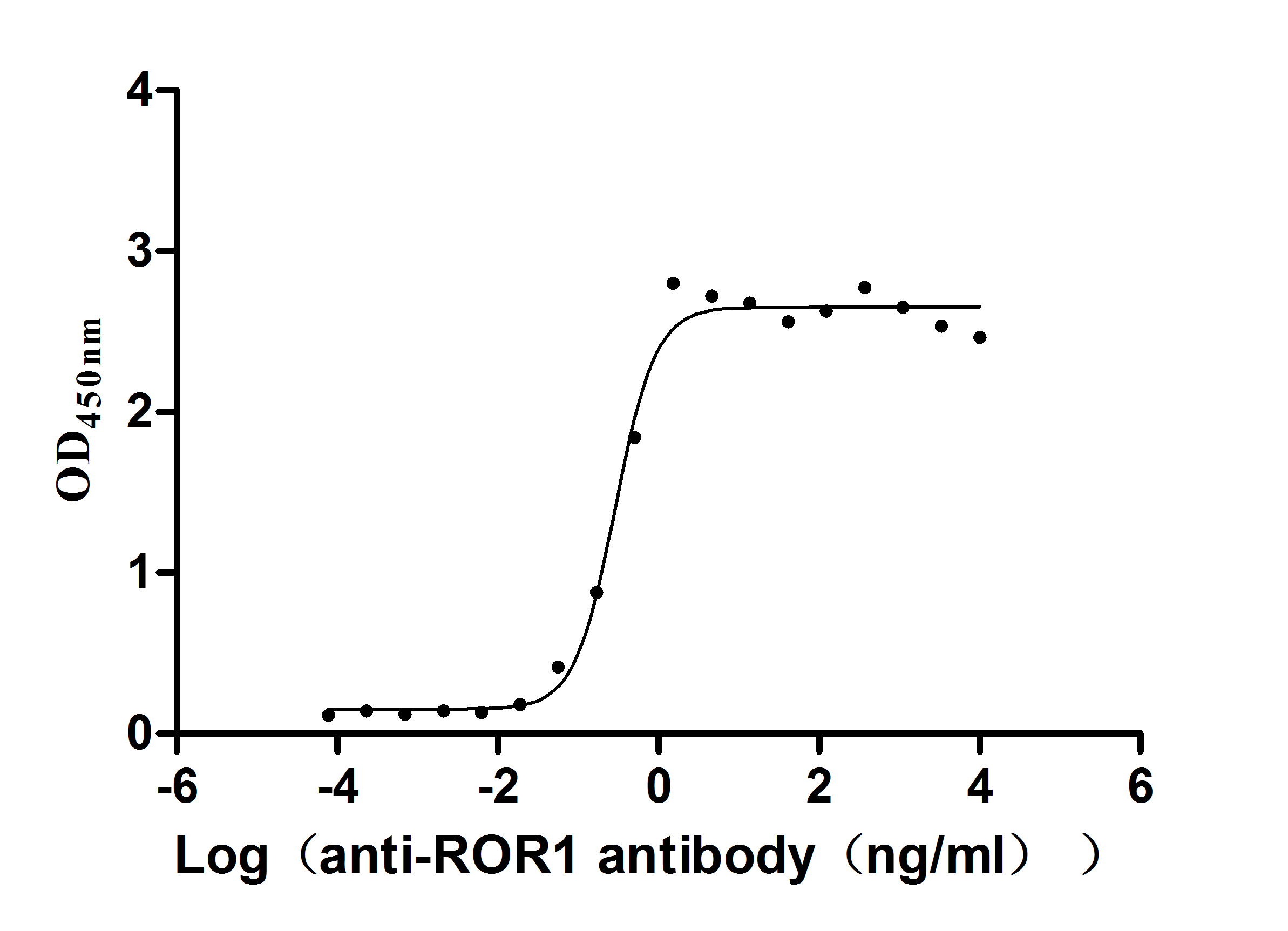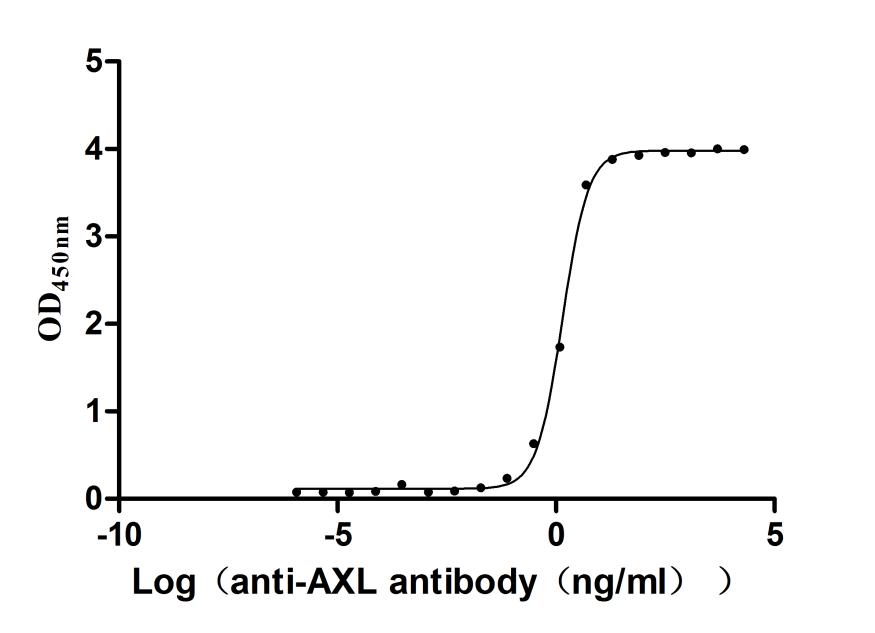Recombinant Rat Mothers against decapentaplegic homolog 2 (Smad2)
-
货号:CSB-YP021787RA
-
规格:
-
来源:Yeast
-
其他:
-
货号:CSB-EP021787RA
-
规格:
-
来源:E.coli
-
其他:
-
货号:CSB-EP021787RA-B
-
规格:
-
来源:E.coli
-
共轭:Avi-tag Biotinylated
E. coli biotin ligase (BirA) is highly specific in covalently attaching biotin to the 15 amino acid AviTag peptide. This recombinant protein was biotinylated in vivo by AviTag-BirA technology, which method is BriA catalyzes amide linkage between the biotin and the specific lysine of the AviTag.
-
其他:
-
货号:CSB-BP021787RA
-
规格:
-
来源:Baculovirus
-
其他:
-
货号:CSB-MP021787RA
-
规格:
-
来源:Mammalian cell
-
其他:
产品详情
-
纯度:>85% (SDS-PAGE)
-
基因名:
-
Uniprot No.:
-
别名:Smad2; Madh2; Mothers against decapentaplegic homolog 2; MAD homolog 2; Mothers against DPP homolog 2; Mad-related protein 2; SMAD family member 2; SMAD 2; Smad2
-
种属:Rattus norvegicus (Rat)
-
蛋白长度:Full Length of Mature Protein
-
表达区域:2-467
-
氨基酸序列SSILPFTPP VVKRLLGWKK SAGGSGGAGG GEQNGQEEKW CEKAVKSLVK KLKKTGRLDE LEKAITTQNC NTKCVTIPST CSEIWGLSTA NTVDQWDTTG LYSFSEQTRS LDGRLQVSHR KGLPHVIYCR LWRWPDLHSH HELKAIENCE YAFSLKKDEV CVNPYHYQRV ETPVLPPVLV PRHTEILTEL PPLDDYTHSI PENTNFPAGI EPQSNYIPET PPPGYISEDG ETSDQQLNQS MDTGSPAELS PTTLSPVNHS LDLQPVTYSE PAFWCSIAYY ELNQRVGETF HASQPSLTVD GFTDPSNSER FCLGLLSNVN RNATVEMTRR HIGRGVRLYY IGGEVFAECL SDSAIFVQSP NCNQRYGWHP ATVCKIPPGC NLKIFNNQEF AALLAQSVNQ GFEAVYQLTR MCTIRMSFVK GWGAEYRRQT VTSTPCWIEL HLNGPLQWLD KVLTQMGSPS VRCSSMS
-
蛋白标签:Tag type will be determined during the manufacturing process.
The tag type will be determined during production process. If you have specified tag type, please tell us and we will develop the specified tag preferentially. -
产品提供形式:Lyophilized powder
Note: We will preferentially ship the format that we have in stock, however, if you have any special requirement for the format, please remark your requirement when placing the order, we will prepare according to your demand. -
复溶:We recommend that this vial be briefly centrifuged prior to opening to bring the contents to the bottom. Please reconstitute protein in deionized sterile water to a concentration of 0.1-1.0 mg/mL.We recommend to add 5-50% of glycerol (final concentration) and aliquot for long-term storage at -20℃/-80℃. Our default final concentration of glycerol is 50%. Customers could use it as reference.
-
储存条件:Store at -20°C/-80°C upon receipt, aliquoting is necessary for mutiple use. Avoid repeated freeze-thaw cycles.
-
保质期:The shelf life is related to many factors, storage state, buffer ingredients, storage temperature and the stability of the protein itself.
Generally, the shelf life of liquid form is 6 months at -20°C/-80°C. The shelf life of lyophilized form is 12 months at -20°C/-80°C. -
货期:Delivery time may differ from different purchasing way or location, please kindly consult your local distributors for specific delivery time.Note: All of our proteins are default shipped with normal blue ice packs, if you request to ship with dry ice, please communicate with us in advance and extra fees will be charged.
-
注意事项:Repeated freezing and thawing is not recommended. Store working aliquots at 4°C for up to one week.
-
Datasheet :Please contact us to get it.
靶点详情
-
功能:Receptor-regulated SMAD (R-SMAD) that is an intracellular signal transducer and transcriptional modulator activated by TGF-beta (transforming growth factor) and activin type 1 receptor kinases. Binds the TRE element in the promoter region of many genes that are regulated by TGF-beta and, on formation of the SMAD2/SMAD4 complex, activates transcription. May act as a tumor suppressor in colorectal carcinoma. Positively regulates PDPK1 kinase activity by stimulating its dissociation from the 14-3-3 protein YWHAQ which acts as a negative regulator.
-
基因功能参考文献:
- TRPM7 depletion inhibited Ang II-induced p-Smad2 expression and collagen synthesis in CFs, whereas increased TRPM7 expression did the opposite. SAN fibrosis is regulated by the Ang II/TRPM7/Smad pathway in SSS, indicating that TRPM7 is a potential target for SAN fibrosis therapy in SSS. PMID: 29511803
- the expression of CTGF, TGF-beta1 and p-SNAD2/3 is tissue-specific and stage-specific, and indicate a regulatory role for a TGF-beta1-SMAD2/3-CTGF signaling pathway in amelogenesis, dentinogenesis and formation of junctional epithelium PMID: 29175126
- Studied the effects of herbal compound 861 on transforming growth factor beta1 (TGF-beta1)/Sma and Mad-related proteins (Smad)/Ski-related novel protein N (SnoN) signal pathway in a rat hepatic fibrosis disease model. PMID: 29402324
- Lastly, the SENP1 knockdown HSC-T6 cells were successfully constructed, while the silence of SENP1 down-regulated the protein expression of alpha-SMA and SMAD2. In conclusion, this study provided a new regulation mechanism about the liver fibrosis process. PMID: 29128362
- results revealed that NaNO2 significantly increased serum tumor necrosis factor-alpha, C-reactive protein, heat shock proteins-70, vascular endothelial growth factor, and Interleukin 6. Moreover, transforming growth factor-beta, hypoxia-inducible factor, Smad-2, Protein Kinase B (AKT), and Bax were overexpressed, whereas Bcl2 protein was downregulated compared with the normoxic group. PMID: 28266762
- hypoxia significantly decreased hemoglobin concentration, while increased expressions of HIF, Bax, Smad-2, TGF-beta, and AKT. PMID: 28000380
- Enhanced expression and phosphorylation of Sirt7 activates smad2 and ERK signaling and promotes the cardiac fibrosis differentiation upon angiotensin-II stimulation. PMID: 28582407
- Smad2 enhances TRAIL-induced apoptosis in activated hepatic stellate cells, which facilitates the resolution of hepatic fibrosis PMID: 26802603
- anti-adipogenic effects of mechanical stretch on mesenchymal stem cells mediated, at least in part, by activation of the TGFbeta1/Smad2 signaling pathway PMID: 26341460
- Antifibrotic effects of luteolin on hepatic stellate cells and liver fibrosis by targeting AKT/mTOR/p70S6K and TGFbeta1/Smad2 signalling pathways. PMID: 25040634
- It is a one of fibrotic genes in kidney fibrosis. PMID: 25178280
- Its signaling is a modulater for progression of hepatocellular carcinoma. PMID: 24329763
- High glucose increases the activity of transcriptional co-regulator p300, which increases transforming growth factor-beta activity via SMAD2 acetylation. PMID: 24886336
- The results of this study suggest that in the hippocampus, ischemia-induced activation of Smad2 and Smad3 is associated with the response to stress but is not related to neuronal survival or death. PMID: 24290497
- CaSR interferes with TGF-beta-dependent Smad2 phosphorylation and induces its proteasomal degradation. PMID: 24273150
- Respiratory exposure to multi-walled carbon nanotubes induced length dependent pulmonary fibrosis and epithelial-derived fibroblasts via TGF-beta1/Smad2 pathway. PMID: 24530353
- Adenoviral overexpression of Smad2 blocked SLPI-induced axonal regeneration. PMID: 23516280
- site-direct mutation analysis of SM22alpha promoter demonstrated that myocardin and Smad2 coactivated SM22alpha promoter mainly depending on CArG box and less on smad binding elements sites PMID: 22362485
- Yiqi Huoxue Formula might inhibit the expression of CTGF through down-regulation of TGF-beta and smad2 and up-regulation of smad7, thus inhibiting the progression of renal interstitial fibrosis. PMID: 21144460
- TIEG-siRNA reduced the expression of Smad2 in diabetic nephropathy. PMID: 20979836
- These findings demonstrate that there is cross-talk between the MAPK (ERK1/2, JNK, p38) and Smad2 pathways, and that the cross-talk interacts mutually to enhance the synthesis of collagen IV in rat mesangial cells. PMID: 20818498
- AVE0991 prevented AngII-inducing myocardial hypertrophy in a dose-dependent fashion, a process that may be associated with the inhibition of TGF-beta1/Smad2 signaling. PMID: 20676968
- Data show that in the endotoxic rat model, pretreatment and simultaneous treatment with propofol provided protection against acute lung injury by inhibiting the TGF-beta1-Smad2 dependent pathway. PMID: 19941153
- Yi Sheng injection and MMF can down-regulate the expression of TGF-beta1 and Smad2 and block the down-regulated expression of Smad7, which may postpone and lessen the progression of chronic allograft nephropathy. PMID: 18095586
- The expression of TGF-beta1/smad2 signaling pathway may play an important role in regulation of pulmonary permeability and development of pulmonary edema in acute lung injury induced by uncontrolled hemorrhagic shock. PMID: 18611337
- TGR1, Smad2, Smad4 and Smad7 might have roles in progression of rat preneoplastic lesions during chemical hepatocarcinogenesis PMID: 12923327
- Decrease in Smad2 resulted from enhanced ubiquitin-dependent degradation of Smad2 mediated by Smurf2 and is involved in regulation of Smad2-mediated TGF-beta signaling in nephritic glomeruli. PMID: 14507671
- Cotransfection of Smad2 and Runx2 constructs had a cooperative effect on TGF-beta 1-stimulated collagenase-3 promoter activity. Ligand-independent physical interaction between Smad2 and Runx2 was identified. PMID: 14982932
- results suggest that Smad2 and SMAD4 proteins are involved in the tissue remodeling of cycling and pregnant rat uteri and transforming growth factor-beta signaling functions PMID: 15036506
- renoprotective effects afforded by AT(1A)-receptor blockade in obstructive uropathy are consistent with attenuation of JNK1- and SMAD2-mediated renal injury. PMID: 15126250
- R-Smads have distinct roles in mediating the expression of pro- and antiangiogenic growth factors in response to TGF-beta1 PMID: 15253713
- TGF-beta or HGF treatment of normal stomach-origin cells activated the JNK pathway, thereafter inducing endogenous R-Smads phosphorylation. PMID: 15326485
- Smad2 and Smad3 have different functions in rat hepatic stellate cells, and signal via independent pathways PMID: 15987742
- The more serious the hepatic fibrosis is in the injured liver, the higher the level of Smad2 and Smad4 gene expression is during and after fibrogenesis respectively. PMID: 16570350
- Smad2 protein has a novel function in regulation of the Cdh1-APC/SnoN pathway of axonal morphogenesis. PMID: 18287512
- High tidal volume ventilation activates the Smad2 pathway, which may be responsible for downstream induction of CTGF expression in newborn rat lungs. PMID: 18287961
显示更多
收起更多
-
亚细胞定位:Cytoplasm. Nucleus.
-
蛋白家族:Dwarfin/SMAD family
-
数据库链接:
KEGG: rno:29357
STRING: 10116.ENSRNOP00000048329
UniGene: Rn.2755
Most popular with customers
-
Express system: Mammalian cell
Species: Homo sapiens (Human)
-
Recombinant Human Carcinoembryonic antigen-related cell adhesion molecule 6 (CEACAM6) (Active)
Express system: Mammalian cell
Species: Homo sapiens (Human)
-
Recombinant Human Tumor-associated calcium signal transducer 2 (TACSTD2), partial (Active)
Express system: Mammalian cell
Species: Homo sapiens (Human)
-
Recombinant Human Transmembrane 4 L6 family member 1(TM4SF1)-VLPs (Active)
Express system: Mammalian cell
Species: Homo sapiens (Human)
-
Recombinant Human Tyrosine-protein kinase receptor UFO(AXL),partial (Active)
Express system: Mammalian cell
Species: Homo sapiens (Human)

















